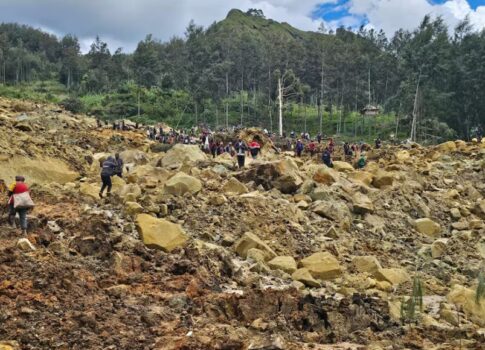 A devastating landslide in Papua New Guinea has led to the presumed deaths of more than 670 people, according to estimates by the U.N. Migration Agency (IOM) on Sunday. This grim figure surpasses initial media reports that suggested over 300 people had been buried by the landslide on Friday.
A devastating landslide in Papua New Guinea has led to the presumed deaths of more than 670 people, according to estimates by the U.N. Migration Agency (IOM) on Sunday. This grim figure surpasses initial media reports that suggested over 300 people had been buried by the landslide on Friday.
Serhan Aktoprak, the chief of the IOM mission in Papua New Guinea, indicated that the death toll might be significantly higher, as the full scope of the catastrophe remains unclear. The perilous conditions have complicated rescue and aid operations, with only five bodies recovered from the debris so far.
“Land is still sliding, rocks are falling, ground soil is cracking due to constant increased pressure and groundwater is running, thus the area poses an extreme risk for everyone,” Aktoprak said in a statement.
The disaster struck Yambali Village in Enga province, where officials reported that more than 150 houses were buried. The landslide has displaced approximately 1,250 people, forcing them to seek temporary shelter with relatives and friends after abandoning more than 250 nearby houses.
Rescue efforts are hampered by the challenging terrain and continuous geological instability. Locals are using basic tools such as digging sticks, spades, and large agricultural forks to search for bodies beneath the soil.
The landslide also buried essential infrastructure, including an elementary school, small businesses, a guesthouse, and a petrol station. The U.N. office in Papua New Guinea reported that five bodies were retrieved from an area where 50 to 60 homes were destroyed, with numerous injuries, including at least 20 women and children.
The IOM expressed concerns that many of the deceased might be children under 15, given the village’s relatively young population.
The disaster has severed the Porgera Highway, a critical route near the Porgera gold mine operated by Barrick Niugini Ltd, a joint venture between Barrick Gold and China’s Zijin Mining. With road access blocked, helicopters are the only means to reach the mine and other isolated areas in Enga Province.
Rescue operations are further delayed as heavy equipment like excavators have not yet arrived, and the community may restrict their use until mourning rituals are completed.
The government plans to establish two care and evacuation centers on either side of the landslide-affected area to provide shelter for those displaced. A humanitarian convoy has begun distributing bottled water, food, clothing, hygiene kits, kitchen utensils, tarpaulins, and personal protective equipment.
CARE Australia reported that nearly 4,000 people lived in the impact zone, but the actual number affected is likely higher, as the area is a refuge for those displaced by conflicts in nearby regions. The landslide has left debris up to 8 meters (25 feet) deep across 200 square kilometers (80 square miles), exacerbating the difficulty of relief efforts.
Prime Minister James Marape stated that disaster officials, the Defence Force, and the Department of Works and Highways are actively involved in the relief and recovery operations.

Biden Withdraws From 2024 Presidential Race, Endorses Kamala Harris
Global Technology Outage Disrupts Key Services Across Multiple Countries
Paul Kagame Wins 99% of Vote In Rwanda’s Presidential Election
Authorities Investigate Shooting At Trump Rally As Assassination Attempt